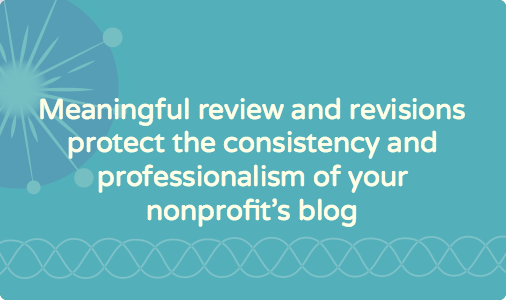There’s a certain aspect of managing blog contributors that can be a difficult or delicate matter: the review and revision process.
But review and revisions are part of protecting the consistency and professionalism of your blog and you need to carry them out with confidence. As managing editor, you are most plugged in to your editorial focus, your audience (and their needs and habits) and of course, your own vision for the blog.
Meaningful review and revisions protect the professionalism of your #nonprofit's blog #NPMC Click To TweetHere are nine tips for managing blog review and revisions tactfully and effectively
1. Provide blog editorial guidelines
Create blog editorial guidelines and then post and share them with every single blogger and potential blogger you work with. Re-share your guidelines with repeat bloggers from time to time. Well-crafted blog editorial guidelines will make your expectations and standards clear, communicate your professionalism and reduce unnecessary communication and revisions later on.
But you can also use your guidelines to guide yourself. When you’re in doubt about changes you’d like to request, ask yourself if your author is adhering to the guidelines you sent her. If she is, edit with a light hand. If she isn’t, go ahead with your revisions or request for changes.
Recently, I asked a Nonprofit MarCommunity blog contributor what she liked about my review and revision process (because she did seem to like it). Here’s one of her comments:
“The editorial guidelines and our preliminary conversations made it crystal clear that I’m working with a professional who knows exactly what she wants and what’s best for her audience. You set the expectations from the start, including asking me to look at examples. Because of this, I was not surprised by the type of edits you suggested.” – Nathalie Noël
2. Allow your contributor’s personal voice and style to shine through
You’re running a multi-author blog because you want to feature a variety of voices. And you invited each author because of his or her expertise and unique perspective. This is one context in which you don’t have to worry about “corporate consistency”, so go ahead and let your author’s voice shine through.
3. Keep your spelling and grammar edits in check
Are you a “grammar nerd”? Good for you (you might have noticed that I am not).
Your passion for grammar is wonderful but don’t let your personal style choices and grammar pet peeves get in the way of providing necessary and meaningful feedback. When you’re editing someone else’s work, err on the side of correct versus an exact match with your own grammar preferences.
4. Consider the post type
Some post content types need to fit a certain model, while others leave more room for creativity.
For example, a how-to post should have certain elements in place, including a clear use of descriptive and explanatory subheadings to guide readers through a process. On the other hand, an opinion piece is more personal and perhaps, more colourful, with more room for creative liberties.
When making a judgment call about how much to edit, consider your post content type.
5. Think about the relationship
Sometimes, your relationship with a blogger affects your ability or comfort level with providing revisions.
For example, are you reviewing a post from your boss or a board member? Was the post written by an external expert who is doing your organization a favour?
Of course, any author should be adhering to your blog’s guidelines – and it helps if you included your boss or other leaders in guideline development or approval. But you do want to think about keeping the relationship positive, fun and appreciative so that you don’t step on any toes and so that they’ll blog for you again. Which brings me to my next few points…
6. Invite revisions vs providing your own
Often, a request for revisions will get a better reception than a huge number of track changes within a document.
For example, if a post is a bit too “light”, think about how you can encourage your author to elaborate or otherwise showcase her expertise more deeply. If possible, give her the opportunity to tweak her own writing rather than putting your words into their mouth (er, post).
Think about how you feel when your work is edited. How much nicer it is to hear, “Can you provide more detail about…? What do you mean when you say…?” versus, “Say this instead.”
If you think copy needs to be streamlined, suggest areas that can be streamlined and give your author the opportunity to do the trimming (or slashing) first.
Inviting contributors to make their own revisions communicates respect and appreciation. And when your bloggers feel respected and appreciated, they’re more likely to want to blog for you again!
Sometimes, a request for revisions will get a better reception than a long list of edits #blogging Click To Tweet7. Be mindful of your tone
What words and tone are you using when you ask for changes? Are you yielding your “power” a little too zealously? Are you coming across as overly critical or even rude?
Since I work with clients, I expect and hope for revisions as part of the process; so when I put on my own “reviewer” hat, I need to be mindful of the tone of my delivery. Others don’t always have the same thick skin when it comes to their work.
Besides, as a managing editor, you’re grateful, so show it! We’ve all heard of a criticism sandwich and frankly, we all like a little pat on the back for our efforts.
Regardless of the level of revisions you require, show your gratitude for the work your author has done for you. Thank her for her expertise, time, creativity, insights, her clever way of framing the topic… Just be sure to share what you like about the post, along with what you’d like to change.
8. Decide what you can live with
Sometimes you will receive a post that, stylistically is a big departure, but which contains insights that your readers will value.
Before you fret about the level of revisions required, consider: can this be an opportunity to experiment with a new style? How comfortable do you feel about going ahead with the new approach, to test reader responsiveness?
9. Know when to walk away
Once in a while, a contributor will completely miss the mark in terms of post content, style of writing…everything. It simply won’t work and can’t be salvaged.
In this case, you might need to refer to your editorial guidelines, acknowledge the lack of fit and move on (but still thank them for their interest and efforts).
Then, think about how you could have handled the screening, topic review or outline process better. Over time, you’ll finesse your system for avoiding this situation.
Thoughts on revisions from a contributor’s point of view
To consider the review process from a contributor’s point of view, here are a few insights from frequent Nonprofit MarCommunity contributor, Suzanne Hallsworth:
“As a writer, it is extremely important for me that someone reviews my work before publishing not just to catch the typos or grammatical errors that I missed but to provide me with meaningful feedback. The feedback I am looking for is constructive criticism to make my writing more appealing to the audience it is intended for.
Tell me if you think the language I am using will or will not resonate with the audience.
Tell me if something I have written is unclear or confusing.
Tell me if something needs more or less details.
Do not just provide feedback such as ‘don’t like this’, ‘change this’ – Tell me why you don’t like it and what you suggest I change it to.
Do not completely rewrite it just so it is written in your style.”
How do you handle this aspect of managing blog contributors?
What am I missing? How do you handle some of the unique challenges of being an in-house reviewer? Please share in the comments!


![Writing stories? Here’s help with your email outreach [swipe copy]](https://moflow.ca/wp-content/uploads/2017/12/StoryWritingEmailSwipeCopy.png)

